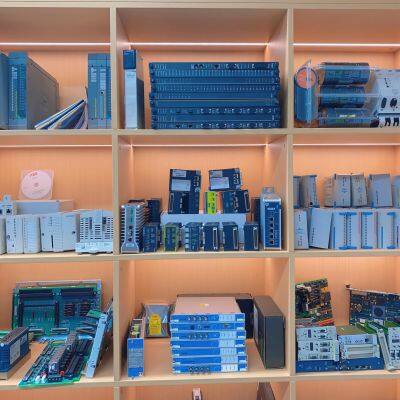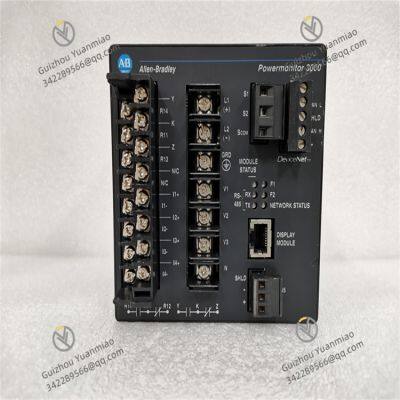Product Description
I. Overview
1404-M405A-DNT is a high-performance main control module in the PowerMonitor 3000 series. It is specially designed for complex industrial automation systems and plays a core hub role in the entire system architecture. It undertakes important responsibilities such as managing communication between connected modules, accurately monitoring and regulating power parameters, ensuring that industrial automation systems can operate stably, efficiently and intelligently.
This module has excellent compatibility with other devices in the same series and various industrial control components (such as Programmable Logic Controllers (PLCs), Human-Machine Interfaces (HMIs), sensors, actuators, etc.), and can be easily integrated into industrial control systems of different scales and complexities. With advanced circuit layout, powerful computing and processing capabilities, and an optimized communication protocol stack, 1404-M405A-DNT can quickly collect and accurately analyze various analog and digital signals in the system, and make timely responses according to preset logic, realizing refined control of the entire industrial production process. Due to its reliable performance, excellent power monitoring and management capabilities, and strong system integration functions, 1404-M405A-DNT is widely used in many fields such as manufacturing, energy industry, transportation, and smart buildings, helping various industries improve production efficiency, optimize energy utilization, and ensure stable operation of equipment.

II. Technical Parameters
(1) Power Parameters
Input Voltage: Supports a wide range of input, with a typical value of 24V DC. It can be adapted to common industrial DC power supply systems and can work stably within a certain range of voltage fluctuations (refer to the product manual for specific fluctuation ranges), enhancing adaptability to complex power supply environments.
Current Consumption: When powered by 24V DC, the normal working current is about 1A, and the power consumption is at a reasonable level, which not only meets the needs of efficient operation of the module but also ensures the economy of energy utilization.
(2) Signal Processing Parameters
Analog Input: Equipped with multiple analog input channels, which can access 4-20mA DC current signals and 0-10V DC voltage signals. It is used to collect analog information such as pressure, temperature, and flow fed back by sensors. The input impedance complies with industrial standards (specific values are subject to the product manual), effectively ensuring the accuracy and stability of signal transmission and reducing the impact of signal attenuation and interference.
Digital Input: Configured with multiple digital input ports, which can quickly respond to 24V DC switching signals, such as status signals of equipment start-stop buttons, limit switches, fault alarms, etc. The response time is as short as milliseconds, which can capture changes in the status of external equipment in real-time and provide timely and accurate input basis for system control logic.
Analog Output: Can output 4-20mA DC current signals or 0-10V DC voltage signals, which are used to transmit the analog data processed by the module to other devices (such as recorders, controllers, regulating valves, etc.). It has high output accuracy and good linearity (specific accuracy parameters refer to the product manual) to meet application scenarios with high requirements for analog control accuracy.
Digital Output: Has multiple digital output ports, which can output 24V DC/1A switching signals for driving external executive components such as relays, indicator lights, and solenoid valves. The output capacity can meet the driving needs of most industrial on-site control equipment, realizing precise start-stop, forward-reverse rotation and other control operations of the equipment.
(3) Power Monitoring Parameters
Current Monitoring: For specific circuits, the rated working current can reach 10A (the "10" in "M405A" in the model is related to this rated current). It can monitor the current in the circuit in real-time. Through high-precision current sensors, it can accurately measure the current value and quickly respond to abnormal current conditions such as overcurrent and short circuit.
Voltage Monitoring: Can accurately monitor three-phase AC voltage or DC voltage, and can adapt to different types of power supply systems. The voltage measurement range is set according to industrial standards, with high measurement accuracy, and can timely detect abnormal conditions such as voltage fluctuations, overvoltage, and undervoltage, providing reliable guarantee for the stable operation of the power system.
Power Monitoring: Can calculate and monitor parameters such as active power, reactive power, and apparent power. By mastering these power parameters in real-time, users can clearly understand the power consumption and power factor status of the system, which helps optimize energy utilization, reduce operating costs, and achieve the production goal of high efficiency and energy saving.
Electric Energy Metering: Has the function of cumulative electric energy metering, which can accurately count the electric energy usage within a period of time, providing accurate data support for energy management and cost accounting, and meeting the strict requirements of industrial enterprises for electric energy metering.
(4) Communication Parameters
Communication Protocols: Supports multiple mainstream industrial communication protocols, such as Modbus, Ethernet/IP, DeviceNet, etc. It can realize seamless communication with industrial automation equipment of different brands and types, facilitating the construction of heterogeneous industrial automation networks, realizing rapid data exchange and sharing, and ensuring the collaborative work of all parts of the system.
Communication Interfaces: Equipped with rich communication interfaces, including RS-485 serial ports, Ethernet interfaces, etc. The RS-485 interface has a long communication distance and strong anti-interference ability, which is suitable for harsh communication environments in industrial sites and can connect devices such as smart electric meters, sensors, and actuators; the Ethernet interface provides high-speed and stable data transmission capabilities, meeting communication scenarios with large data volume and high real-time requirements, and facilitating remote data interaction and monitoring management with upper computers and cloud platforms.
(5) Control Performance Parameters
Control Methods: Provides a variety of flexible control methods, such as control logic based on parameters such as voltage, current, power, and time. Users can freely choose and combine through programming or parameter settings according to actual production process requirements, realizing precise regulation of equipment operating status to adapt to the diverse control requirements of different industrial application scenarios.
Response Time: The response time of control commands is extremely short. From receiving the control signal to executing the corresponding action, it is usually within milliseconds, ensuring that the system can quickly respond to various changes, effectively improving the dynamic performance and real-time control ability of the system, and ensuring the efficiency and stability of the industrial production process.
(6) Protection Function Parameters
Overcurrent Protection: When the module detects that the current in the circuit exceeds the rated value, it will quickly trigger the overcurrent protection mechanism, automatically cut off the relevant circuit or limit the current output, preventing damage to the module itself and connected equipment due to overcurrent. The protection action time is short, which can effectively avoid the expansion of faults.
Short-Circuit Protection: Once a short-circuit fault at the output end is detected, the short-circuit protection function takes effect immediately, cutting off the power supply in a very short time to avoid irreversible damage to the equipment caused by excessive short-circuit current and ensure the safe operation of the system.
Overvoltage Protection: When the input voltage or the internal circuit voltage of the module rises abnormally and exceeds the set safety threshold, the overvoltage protection function is activated. It protects the sensitive components inside the module through measures such as voltage reduction and voltage limitation, preventing damage due to overvoltage and maintaining the normal working state of the system.
Undervoltage Protection: When the input voltage is lower than the normal working range, the undervoltage protection function is turned on, timely sending out an alarm signal and taking corresponding measures (such as stopping the operation of some non-critical equipment) to prevent the module and connected equipment from working in a low-voltage state, which may affect equipment performance or cause equipment damage, ensuring the reliability of the system operation.
Overheating Protection: The module is integrated with a high-precision temperature sensor to monitor the working temperature of the module in real-time. When the temperature exceeds the maximum allowable value, the overheating protection mechanism is automatically activated. It makes the module temperature return to the normal range by means of accelerating heat dissipation through cooling fans, reducing the working power of the module, or temporarily stopping work, avoiding performance degradation or damage of components due to overheating, and prolonging the service life of the module.
(7) Environmental Adaptability Parameters
Operating Temperature: Can work stably within a relatively wide temperature range. Usually, the operating temperature range is -20°C to +60°C (specific range is subject to the product manual). It can adapt to the temperature conditions of different industrial places, whether it is a high-temperature production workshop or a low-temperature storage environment, it can ensure the normal operation of the module and protect the industrial automation system from the impact of temperature changes.
Relative Humidity: Can operate reliably in an environment with a relative humidity of 5%-95% (non-condensing state), with good moisture-proof performance. It is suitable for industrial environments with high humidity such as textile factories and food processing factories, effectively avoiding circuit short circuits, corrosion and other faults caused by humidity problems, and ensuring long-term stable operation of the module.
Protection Level: Generally, the protection level is IP20, which is suitable for indoor installation environments. It can prevent the intrusion of solid foreign objects larger than 12mm and avoid damage to the module caused by dust accumulation; at the same time, direct contact with liquids should be avoided. In practical applications, it is often installed in a control cabinet, and the overall protection effect is further improved by means of the protective measures of the control cabinet to adapt to the complex and changeable industrial on-site environment.

III. Functional Features
(1) Accurate Power Parameter Monitoring and Analysis
1404-M405A-DNT has a built-in high-precision power monitoring chip and advanced algorithms, which can collect and analyze various parameters in three-phase AC or DC power systems in real-time and accurately, including voltage, current, power, power factor, frequency, electric energy, etc. Through continuous monitoring and in-depth analysis of these parameters, users can fully understand the operating status of the power system, timely find potential power problems such as voltage fluctuations, current imbalance, and low power factor, and take corresponding measures to optimize and adjust, ensuring the stable and efficient operation of the power system, and improving the service life of equipment and production efficiency.
(2) Flexible and Diverse Control Logics and Strategies
This module supports users to customize rich control logics and strategies according to actual industrial production needs. Users can easily set control rules based on various power parameters, equipment status, and time series through programming software, realizing automatic control and intelligent management of equipment. For example, according to the fluctuation of grid voltage, automatically adjust the operating power of the equipment to avoid equipment damage caused by abnormal voltage; reasonably allocate power resources according to different stages of the production process to optimize energy utilization efficiency; or automatically trigger the input of standby equipment when the equipment fails to ensure the continuity of the production process. This flexible and diverse control function enables 1404-M405A-DNT to perfectly adapt to various complex and changeable industrial application scenarios, providing users with personalized and customized solutions.
(3) Strong Communication and System Integration Capabilities
1404-M405A-DNT has excellent communication functions, supporting multiple industrial communication protocols, and can realize seamless connection and data interaction with industrial automation equipment of different brands and types. Through communication interfaces such as RS-485 serial ports and Ethernet interfaces, it can quickly and stably transmit the collected power data to upper computers, PLCs, HMIs and other equipment, realizing centralized monitoring and management of data; at the same time, it can also receive control commands from these equipment to realize remote control of the power system and related equipment. In addition, the module can also be integrated with smart grids, energy management systems, enterprise information platforms, etc., integrating power data into the overall operation and management system of the enterprise, providing strong data support for enterprise decision-making and analysis, and promoting enterprises to realize digital and intelligent transformation.
(4) Perfect and Reliable Fault Diagnosis and Protection Mechanisms
To ensure the safe and reliable operation of industrial automation systems, 1404-M405A-DNT is equipped with all-round and multi-level fault diagnosis and protection functions. The module integrates multiple sensors and intelligent diagnosis algorithms, which can monitor the operating status of itself and connected equipment in real-time, and quickly detect and accurately diagnose common faults such as overcurrent, short circuit, overvoltage, undervoltage, and overheating. Once a fault is detected, the module will immediately take corresponding protection measures, such as cutting off the fault circuit, sending an alarm signal, recording fault information, etc., to prevent the fault from further expanding and protect the safety of equipment and personnel. At the same time, users can conveniently view fault information and historical records through the module's display screen, communication interface or upper computer software, quickly locate the cause of the fault, and carry out targeted maintenance and treatment, effectively shortening the system downtime and improving production efficiency.
(5) Convenient and Efficient Parameter Setting and Debugging Functions
1404-M405A-DNT provides an intuitive and convenient parameter setting and debugging interface. Users can easily complete the setting and adjustment of various parameters through the module's own buttons, display screen, or using special programming software. During the equipment installation and debugging stage, users can quickly configure the module's communication parameters, power monitoring parameters, control logic parameters, etc., to ensure the compatibility and matching degree between the module and the entire system; during the equipment operation process, users can also modify and optimize parameters at any time according to actual needs to realize flexible regulation of the system's operating status. In addition, the module also supports online debugging function, allowing users to monitor the module's operating data and status in real-time, verify and optimize the control logic, which greatly improves the efficiency of equipment installation, debugging, maintenance and management.
(6) Stable and Reliable Long-Term Operation Performance
In the field of industrial automation, the long-term stable operation of equipment is crucial. 1404-M405A-DNT uses high-quality components and advanced manufacturing processes, and has passed strict quality inspection and reliability testing to ensure that it can still maintain stable and reliable performance in long-term and high-intensity working environments. The internal circuit design of the module fully considers factors such as electromagnetic compatibility and anti-interference, effectively reducing the impact of external interference on the module's operation; at the same time, the optimized heat dissipation structure and thermal management system ensure the normal operation of the module in high-temperature environments. In addition, the module also has good anti-vibration and anti-shock performance, which can adapt to the complex and changeable physical environment of industrial sites, providing a solid guarantee for the long-term stable operation of industrial automation systems.


Allen-Bradley 1783-MS10T Ethernet Managed Switches
Allen-Bradley 1786-RPFPXLB ControlLogix Processor Module
Allen-Bradley 1398-DDM-075 Ultra Series Servo Drive
Allen-Bradley 1784-KTX Communication Interface Card
Allen-Bradley 1784-PCIC Communication Interface Card
Allen-Bradley 1784-PKTX Network Interface Card
Allen-Bradley 1797-PS2E2 FLEX Ex Power Supply Module
Allen-Bradley 2094-BC04-M03-S Kinetix 6000 Integrated Axis Module
Allen-Bradley 2094-BM01-S Class Axis Module
Allen-Bradley 2094-EN02D-M01-S1 Kinetix 6200/6500 Control Module
Allen-Bradley 2098-DSD-020X Ultra 3000 Digital Servo Drive
Allen-Bradley 5204-DFNT-PDPMV1 EtherNet/IP Communication Module
Allen-Bradley 5302-MBP-MCM4MB EtherNet/IP Communication Module
Allen-Bradley 80026-044-06-R Power Supply
Allen-Bradley 80190-300-01-R Original Packaging Module
Allen-Bradley 81001-450-53-R Circuit Board
Allen-Bradley 80190-580-01-R Drive Processor Module
Allen-Bradley 81001-340-71-R High-Performance PLC Module
Allen-Bradley 81007-465-51-R Voltage Sensing Board
Emerson 1C31194G04 Valve Positioner Module
Emerson A6110 9199-00001 AMS Shaft Relative Vibration Monitor
Emerson A6120 9199-00002 Relative Vibration Monitor
Emerson A6140 9199-00058 Relative Vibration Monitor
Emerson A6210 9199-00003 Vibration Monitoring Module
 yezi
Hi there! Welcome to my shop. Let me know if you have any questions.
yezi
Hi there! Welcome to my shop. Let me know if you have any questions.




